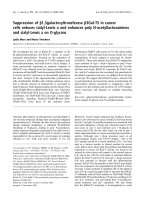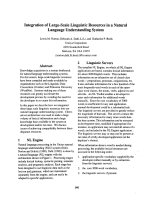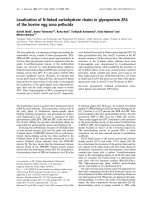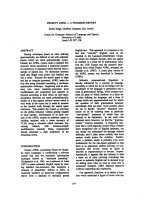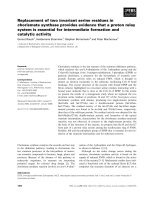Báo cáo khoa học: " Management of a rare case of arrhythmogenic right ventricular dysplasia in pregnancy: a case report" pot
Bạn đang xem bản rút gọn của tài liệu. Xem và tải ngay bản đầy đủ của tài liệu tại đây (285.2 KB, 4 trang )
CAS E RE P O R T Open Access
Management of a rare case of arrhythmogenic
right ventricular dysplasia in pregnancy:
a case report
Nilgün Güdücü
1*
, Salih Serdar Kutay
2
, Ebru Özenç
3
, Çavlan Çiftçi
3
, Alin Başgül Yiğiter
1
and Herman İşçi
1
Abstract
Introduction: Arrhythmogenic right ventricu lar dysplasia is a heritable disease of the heart muscle characterized by
fibrofatty degeneration of cardiomyocytes. Patients present with ventricular arrhythmias or congestive heart failure,
and sometimes sudden cardiac death occurs. Prenatal diagnosis has become possible with the detection of
mutations, but, to the best of our knowledge, no case of prenatal diagnosis has been reported previously. There is
little information about the management of arrhythmogenic right ventricular dysplasia in pregnancy, and the
preferred mode of delivery is not certain; therefore, we present the case of a patient with arrhythmogenic right
ventricular dysplasia and discuss the prenatal diagnosis, patient management and prognosis in pregnancy.
Case presentation: A 26-year-old Caucasian woman who presented to our hospital with heart palpitations was
diagnosed with arrhythmogenic right ventricular dysplasia, and, after three years of follow up with anti-arrhythmic
drugs, she wanted to conceive. During pregnancy, she ceased taking her medication. She tolerated pregnancy very
well but her cardiac symptoms recurred after her 30th week of pregnancy. She delivered a baby via cesarean
section under general anesthesia in her 38th week of pregnancy. She was discharged without any medications and
continued lactation for six months.
Conclusion: Patients with mild to moderate arrhythmogenic right ventricular dysplasia tolerate pregnancy and
breastfeeding very well, but patients with end-stage arrhythmogenic right ventricular dysplasia should be
discouraged from conception.
Introduction
Arrhythmogenic right ventricular dysplasia (ARVD) is an
autosomal dominant inherited disease of the heart muscle
characterized by fibrofatty degeneration of cardiomyo-
cytes, which leads to electrical instability and contractility
abnormalities. Most patients present with ventricular
arrhythmias and later develop right ventricular failure due
to progressive muscle damage, but in 7% to 29% of
patients the first manifestation of the disease can be
sudden cardiac death [1].
Several genes encoding desmosomal proteins have
been associated with ARVD [2], and although they can
be detected in only 50% of patients, prenatal diagnosis
can be considered. Pregnancies with dilated and
hypertrophic cardiomyopathies are common, but only a
few cases of pregnancies with ARVD have been
reported. Therefore, it is difficult to assess the risks of
pregnancy and delivery in patients with ARVD. Here we
discuss the management of a patient with ARVD during
pregnancy, delivery and the postpartum period, together
with the possibility of prenatal diagnosis.
Case presentation
A 26-year- old Caucasian woman presented to cardiology
polyclinics with heart palpitations and shortness of breath.
The patient’s mother had died when she was 35 years old
as a result of sudden cardiac arrest (SCA), and her grand-
mother had died a s a result o f congestive heart failure
(CHF). The patient’s body mass index was 24 kg/m
2
. The
24-hour electrocardiographic (ECG) monitoring documen-
ted 2602 bi-geminal, tri-geminal and quadri-geminal
ventricular extrasystoles per hour as well as ventricular
* Correspondence:
1
İstanbul Bilim University, School of Medicine, Department of Obstetrics and
Gynecology, Kısıklı cad. No. 106, 34692, İstanbul, Turkey
Full list of author information is available at the end of the article
Güdücü et al. Journal of Medical Case Reports 2011, 5:300
/>JOURNAL OF MEDICAL
CASE REPORTS
© 2011 Güdücü et al; licensee BioMed Central Ltd. This is an Open Access article distributed under the terms of the Creativ e Commons
Attribution License ( which permits unrestr icted use, distribution, and reproduction in
any medium, provided the original work is properly cited.
tachycardia (VT) episodes. The duration of filtered QRS
was more than 120 ms. Her echocardiogram was within
the normal ranges. Cardiac non-contrast-enhanced mag-
netic resonance imaging (MRI) showed diffuse thinning of
the right ventricle and local dilation in the right ventricu-
lar wall with segmental hypokinesia. The electrophysiolo-
gical study revealed sustained non-inducible VT,
low-amplitude areas in the right ventricular outflow tract
and ventricular ectopic beats originating in the right ven-
tricular outflow tract. B ecause VT was non-inducible,
neither the use of an implanted cardioverter-defibrillator
(ICD) nor ablation was considered. There was right ventri-
cular dilation and apical mild hypokinesia. She had no
signs of left ventricular dysfunction. On the basis of these
results, the diagnosis of ARVD was made according to the
original Intern ational Task For ce diagnostic criteria. She
was prescribed metoprolol and propafenone. She avoided
physical stress and did very well with pharmacological
treatment. After three years of follow-up, she w anted to
conceive. She was counseled that only a few pregnancies
have been reported in patients with ARVD and that the
risk of transmission of the disease to the offspring is 50%.
A mutation screening was offered, but she refused the
mutation screening because of t he high cost. She con-
ceived and ceased her medications but did very well
during her pregnancy until term.
A fetal echocardiogram was performed at the 21st
week of pre gnancy, and after delivery no abnormality
was detected. In the third trimester, she had heart palpi-
tations and became symptomatic again. The 24-hour
ECG monitoring at the 32nd week of pregnancy docu-
mented 16,251 ventricular extrasystoles.
She delivered at the 38th week of pregnancy by elec-
tive cesarean section while under general anesthesia.
After three days of hospitalization, she was discharged
without medications and continued breastfeeding for six
months.
Discussion
The diagnosis of ARVD is based upon a set of major and
minor criteria proposed by the Intern ational Task Force.
Patients must either meet two major criteria comprising
one major and two minor criteria or meet four minor cri-
teria t o be diagnosed with ARVD. In 1994, the Interna-
tional Task Force proposed criteria for the clinical
diagnosis of ARVD [3]. Structural, histological, electro-
cardiographic, arrhythmic and familial features of the dis-
ease were incorporated into the criteria an d subdivided
into minor and major categories. Although the 1994 cri-
teria were highly specific, they lacked sensitivity for early
and familial cases. In 2010, the International Task Force
criteria were revised [4]. The revision of the diagnostic
criteria provides advances in the genetics of ARVD. To
improve sensitivity, quantitative criteria w ere proposed
and abnormalities were compared with the values of
healthy individuals. O n the basis of this knowledge, in
our case the patient’spresentationisconsistentwiththe
original International Task Force Criteria comprising
four minor cri teria for the diagnosis. One criterion is
hypokinesis of the right ventricle observed by MRI and
ang iography. However, the MRI, angiographic and e cho-
cardiographic findings that we used to diagnosis our
patient with ARVD apparently ar e not consistent with
the revised International Task Force criteria, because in
the revised criteria right ventricular akinesis, dyskinesia
and aneurysms are included. On the other hand, the new
arrhythmia, ECG and family historycriteriasupportour
diagnosis with four minor criteria. ARVD has variable
manifestations, and disease progression occurs in several
phases; therefore, our patient will continue to be followed
up closely in the coming years.
ARVD has variable penetrance and incomp lete expres-
sion [5]. The inheritance of a mutation previously identi-
fied in a proband does not imply a diagnosis of ARVD
when clinical diagnostic criteria are not met. Genetic ana-
lysis cannot predict clinical phenotype and risk stratifica-
tion, but can enable exclusion from lifelong clinical
follow-up when a mutation is not detectable. Seven muta-
tions at different loci have been associated with ARVD,
but they do not explain intra-familial variation and gender
differences. Our patient refused mutation screening
because of the high cost. Although genetic screening and
prenatal diagnosis are possible, a prenatally diagnosed
mutation has not been reported yet. When a mutation is
detected prenatally, this does not mean that the offspring
will certainly develop ARVD phenotype in the future, so it
is not ethical to terminate the pregnancy even if the muta-
tion is present. The age of onset of symptoms has been
reported to be earlier in the younger generations com-
pared t o older generations [6]. The family history in our
case supports this theory because the disease appeared at
an earlier age in the coming generation and decreased life
expectancy. If these characteristics are supported in future
case reports, genetic screening and prenatal diagnosis may
become common.
Mutations affecting components of th e cardiac desmo-
somes are believed to disrupt cell-to-cell adhesion, leading
to the detachment of myocytes under conditions of
mechanical stress [7]. This in turn might lead to apoptosis
and cell necrosis and then to inflammation and repair by
fibrofatty tissue.
During pregnancy, plasma volume, cardiac output and
heart rate increase, hematocrit decreases and physio logic
anemia are established. These changes are required for
the adaptation of the cardiovascular system to pregnancy.
In the presence of maternal heart disease, the patient’s
hematocrit level should be kept between 30% and 35% to
prevent complications. Only a few pregnancies associated
Güdücü et al. Journal of Medical Case Reports 2011, 5:300
/>Page 2 of 4
withARVDhavebeenreported,and,tothebestofour
knowledge, there has been no reported pregnancy asso-
ciated with end-stage ARVD. Therefore, it is not possible
to predict whether p atients with ARVD are able to toler-
ate the hemodynamic changes of pregnancy. Our patient
tolerated pregnancy very well, and no progression of dis-
ease extent was detected o n the basis of 24-hour ECG
and echocardiography at the 32nd week of pregnancy
and after delivery. As reported previously, patients with a
mild or moderate form of the disease tolerate the h emo-
dynamic changes due to pregnancy well, but some of
them become symptomatic in the last trimester a nd
puerperium [8]. Our patient refused to take her medica-
tions during pregnancy and she fared very well un til full
term. She experienced some heart palpitations and chest
discomfort after t he 32nd w eek of pre gnancy. She was
advised to take b-blockers, as these drugs are consi dere d
relatively safe in pregnanc y, but she refused to take these
drugs. Treatment of ARVD is based on the prevention of
arrhythmia with b-blockers, especially with sotalol, which
prevents arrhythmia caused by ARVD in 60% to 70 % of
patients [9]. Propafenone is reported to be safe in the
treatment of ventricular arrhythmia during pregnancy
[10]. ICD use is recommended for patients who have had
a documente d episode of sustained VT or cardiac arrest
or who have high-risk features for SCA [11]. ICD can
prevent sudden cardiac death in early- to mid-stage
ARVD,butinend-stageARVDwithCHF,theprognosis
is poor [12]. Patients with end-stage ARVD and CHF
should avoid pregnancy.
In the puerperial period, our patient refused starting
anti-arrhythmic drug therapy because she wanted to
breastfeed. Although lactation has been reported to
decrease matern al electrolyte stores [13] and is not
advised, our patient’ s weekly magnesium, sodium and
potassium plasma levels were normal during the puer-
perial period. Therefore, we do not advise abstaining
from b reastfeedi ng in early- or mid-stage ARVD, when
the patient is not using drugs or when the drugs are
safe for breastfeeding.
Ten percent of sudden deaths of patients with ARVD
occur in stressful conditions and 10% occur in the pe ri-
operative period [14]. Only a few cases of pregnancy in
patients with ARVD have been reported. Although the
preferred mode of delivery in women with ARVD is not
certain, Bauce et al. [8] reported six cases of pregnancies
in women with ARVD. Four of these women chose deliv-
ery by cesarean section, and two patients with less severe
ARVD allowed vaginal delivery. We preferred to perform
elective cesarean section in our patient while she was
under general anesthesia to avoid strenuous labor and the
hemodynamic changes of epidural anesthesia. Cardiovas-
cular collapse during anesthesia in patients with ARVD
has been reported to be unresponsive to resuscitation, and
most of these patients did not have pre-existent arrhyth-
mia [15].
Conclusion
Pregnancies complicated by mild to moderate ARVD
can be managed successfully with close monitoring and
anti-arrhythmic drugs when necessary , but patients with
end-stage ARVD should be discouraged from conceiv-
ing. Breastfeeding should be permitted in patients with
mild to moderate ARVD with close electrolyte monitor-
ing. Prenatal screening is possible, but terminating the
pregnancy after the detection of a mutation does not
seem ethical.
Consent
Written informed consent was obtained from the patient
for publication of this case report and any accompany-
ing images. A copy of the written consent is available
for review by the Editor-in-Chief of this journal.
Author details
1
İstanbul Bilim University, School of Medicine, Department of Obstetrics and
Gynecology, Kısıklı cad. No. 106, 34692, İstanbul, Turkey.
2
Ümraniye
Education and Research Hospital, Department of Cardiovascular Surgery,
İstanbul, Turkey.
3
İstanbul Bilim University, School of Medicine, Department
of Cardiology, İstanbul, Turkey.
Authors’ contributions
NG and ÇÇ conducted patient follow-up during the patient’s pregnancy in
the obstetrics and cardiology polyclinics. SSK interpreted the patient data. Hİ
and EÖ were the attending surgeons for the cesarean section. ABY provided
the peri-natology consultation. NG was the major contributor to the
manuscript. All authors read and approved the final manuscript.
Competing interests
The authors declare that they have no competing interests.
Received: 19 November 2010 Accepted: 10 July 2011
Published: 10 July 2011
References
1. Corrado D, Basso C, Rizzoli G, Schiavon M, Thiene G: Does sports activity
enhance the risk of sudden death in adolescents and young adults?
J Am Coll Cardiol 2003, 42:1959-1963.
2. Fressart V, Duthoit G, Donal E, Probst V, Deharo JC, Chevalier P, Klug D,
Dubourg O, Delacretaz E, Cosnay P, Scanu P, Extramiana F, Keller D,
Hidden-Lucet F, Simon F, Bessirard V, Roux-Buisson N, Hebert JL, Azarine A,
Casset-Senon D, Rouzet F, Lecarpentier Y, Fontaine G, Coirault C, Frank R,
Hainque B, Charron P: Desmosomal gene analysis in arrhythmogenic
right ventricular dysplasia/cardiomyopathy: spectrum of mutations and
clinical impact in practice. Europace 2010, 12:861-868.
3. McKenna WJ, Thiene G, Nava A, Fontaliran F, Blomstrom-Lundqvist C,
Fontaine G, Camerini F: Diagnosis of arrhythmogenic right ventricular
dysplasia/cardiomyopathy. Task Force of the Working Group Myocardial
and Pericardial Disease of the European Society of Cardiology and of
the Scientific Council on Cardiomyopathies of the International Society
and Federation of Cardiology. Br Heart J 1994, 71:215-218.
4. Marcus FI, McKenna WJ, Sherill D, Basso C, Bauce B, Bluemke DA, Calkins H,
Corrado D, Cox MG, Daubert JP, Fontaine G, Gear K, Hauer R, Nava A,
Picard MH, Protonotarios N, Saffitz JE, Sanborn DM, Steinberg JS, Tandri H,
Thiene G, Towbin JA, Tsatsopoulou A, Wichter T, Zareba W: Diagnosis of
arrhythmogenic right ventricular cardiomyopathy/dysplasia: proposed
modification of the task force criteria. Circulation 2010, 121:1533-1541.
Güdücü et al. Journal of Medical Case Reports 2011, 5:300
/>Page 3 of 4
5. Dalal D, James C, Devanagondi R, Tichnell C, Tucker A, Prakasa K, Spevak PJ,
Bluemke DA, Abraham T, Russell SD, Calkins H, Judge DP: Penetrance of
mutations in plakophilin-2 among families with arrhythmogenic right
ventricular dysplasia/cardiomyopathy. J Am Coll Cardiol 2006,
48:1416-1424.
6. Maithili D, Pamuru PR, Mohiuddin K, Remersu S, Calambur N, Oruganti SS,
Nallari P: Clinical picture of arrhythmogenic right ventricular dysplasia/
cardiomyopathy patients from Indian origin. Indian Pacing Electrophysiol J
2009, 9:5-14.
7. Sen-Chowdry S, Syrris P, Ward D, Asimaki A, Sevdalis E, McKenna WJ:
Clinical and genetic characterization of families with arrhythmogenic
right ventricular dysplasia/cardiomyopathy provides novel insights into
patterns of disease expression. Circulation 2007, 115:1710-1720.
8. Bauce B, Daliente L, Frigo G, Russo G, Nava A: Pregnancy in women with
arrhythmogenic right ventricular cardiomyopathy/dysplasia. Eur J Obstet
Gynecol Rep Biol 2006, 127:186-189.
9. Wichter T, Borggeffe M, Haverkamp W, Chen X, Breithardt G: Efficacy of
antiarrhythmic drugs in patients with arrhythmogenic right ventricular
disease. Circulation 1992, 86:29-37.
10. Brunozzi LT, Meniconi L, Chiocchi P, Liberati R, Zuanetti G, Latini R:
Propafenone in the treatment of chronic ventricular arrhythmias in a
pregnant patient. Br J Clin Pharmacol 1988, 26:489-490.
11. Zipes DP, Camm AJ, Borggrefe M, Buxton AE, Chaitman B, Fromer M,
Gregoratos G, Klein G, Moss AJ, Myerburg RJ, Priori SG, Quinones MA,
Roden DM, Silka MJ, Tracy C, Smith SC Jr, Jacobs AK, Adams CD,
Antman EM, Anderson JL, Hunt SA, Halperin JL, Nishimura R, Ornato JP,
Page RL, Riegel B, Blanc JJ, Budaj A, Dean V, Deckers JW, et al: American
College of Cardiology/American Heart Association Task Force; European
Society of Cardiology Committee for Practice Guidelines; European
Heart Rhythm Association; Heart Rhythm Society. ACC/AHA/ESC 2006
Guidelines for Management of Patients With Ventricular Arrhythmias
and the Prevention of Sudden Cardiac Death: a report of the American
College of Cardiology/American Heart Association Task Force and the
European Society of Cardiology Committee for Practice Guidelines
(writing committee to develop Guidelines for Management of Patients
with Ventricular Arrhythmias and the Prevention of Sudden Cardiac
Death): developed in collaboration with the European Heart Rhythm
Association and the Heart Rhythm Society. Circulation 2006, 114 :
e385-e484.
12. Komura M, Suzuki J, Adachi S, Takahashi A, Otomo K, Nitta J, Nishizaki M,
Obayashi T, Nogami A, Satoh Y, Okishige K, Hachiya H, Hirao K, Isobe M:
Clinical course of arrhythmogenic right ventricular cardiomyopathy in
the era of implantable cardioverter-defibrillators and radiofrequency
catheter ablation. Int Heart J 2010, 51:34-40.
13. Mela T, Galvin JM, McGovern BA: Magnesium deficiency during lactation
as a precipitant of ventricular tachyarrhythmias. Pacing Clin Electrophysiol
2002, 25:231-233.
14. Turrini P, Corrado D, Basso C, Nava A, Thiene G: Noninvasive risk
stratification in arrhythmogenic right ventricular cardiomyopathy. Ann
Noninvasive Electrocardiol 2003, 8:161-169.
15. Houfani B, Meyer P, Merckx J, Roure P, Padovani JP, Fontaine G, Carli P:
Postoperative sudden death in two adolescents with myelomeningocele
and unrecognized arrhythmogenic right ventricular dysplasia.
Anesthesiology 2001, 95:257-259.
doi:10.1186/1752-1947-5-300
Cite this article as: Güdücü et al.: Management of a rare case of
arrhythmogenic right ventricular dysplasia in pregnancy: a case report.
Journal of Medical Case Reports 2011 5:300.
Submit your next manuscript to BioMed Central
and take full advantage of:
• Convenient online submission
• Thorough peer review
• No space constraints or color figure charges
• Immediate publication on acceptance
• Inclusion in PubMed, CAS, Scopus and Google Scholar
• Research which is freely available for redistribution
Submit your manuscript at
www.biomedcentral.com/submit
Güdücü et al. Journal of Medical Case Reports 2011, 5:300
/>Page 4 of 4


